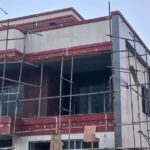
Beam in architecture or the concept of Building Information Modeling is a new approach in the architecture and construction industry that uses information technology and 3D modeling to manage information related to a construction project. In BIM , information related to all aspects of a project from initial design to implementation and operation is gathered in a 3D model .
In this part of the architecture, spatial information, geometry, materials, mechanical and electrical systems, time planning, costs and other details related to the project are drawn in a digital model. This model allows all members of the project team to keep the information up to date and work simultaneously and in harmony with each other .
One of the important points of BIM is to increase efficiency in different stages of the project, reduce errors and interactions, improve decisions and increase compliance with construction standards. This architecture allows detailed project analysis and provides project managers with detailed information to manage costs, schedules, and required resources .
Therefore, BIM as a new approach in the construction industry uses technology and modeling to improve the efficiency, quality and management of construction projects and has had an important impact on improving the processes of the architecture and construction industry. In the following, we will discuss the important points of BIM in architecture .
BIM or rather what exactly is BIM?
If you have searched at the level of books or other internet pages, you have probably come to the conclusion that a clear and perhaps simple, fluent and understandable explanation about BIM has not been provided, but our effort was to reach a more tangible concept that We stated below .
fear or Building Information Modeling ( BIM ) is a set of software tools that provide us with the ability to visualize our desired design in more realistic dimensions and by examining different angles and different views of that plan and idea .
Building information modeling helps all the executive forces in the project so that they can examine the building virtually in all dimensions and experience the ultimate work without having to do the work .
Dr. Taghods, a member of the Faculty of Tehran University, a lecturer of the Construction Management Department of Tehran University, says the following about BIM :
- can see a real model of his project with the help of VR technology, and this issue will bring great help in managing changes and reducing the cost of changes during implementation .
- Because building information modeling has a correct database, the employer can use this correct information during the operation phase. In fact, it helps a lot to have projects certified. This issue is while blueprints are being prepared for the existing projects, but these blueprints have not been used in practice and so far have not been able to provide correct information to the employer during the operation phase .
- Building information modeling with the help of timely project management and planning will play an effective role in reducing costs, increasing quality and basic scheduling of projects .
What exactly is fear not?
look at BIM based on this thinking, but they should change this view right from the beginning of this article. to do
Revit software and it should be BIM consider it in the first place as a science like the science of architecture. For example, when it comes to software AutoCAD If we ask a normal person, he probably considers this software to be architecture, while architectural experts know that AutoCAD alone is worthless without having the knowledge of architecture .
The same example can be used for the relationship between software such as ITBS and structural design science. After the very beginning of the article, we must know the model Creating building information It is an emerging science but extremely practical and useful, with the help of it and the available tools, we can see a complete, comprehensive and digital model of our project in the computer and check the aspects of our project with it .
Where did building information modeling come from and why?
You may not care much about what the history of fear is and where it comes from, but since every history has information that may be useful, hearing a brief history of fear and its causes may be helpful. Building information modeling is not without grace .
In the years before 1970, all maps, including construction and non-construction maps, were drawn by humans. In the past, architects and cartographers would spread very large pieces of paper on the floor of a roofed area, and with their help, they would begin to draw building plans and create each and every component they could in those plans with a pencil. And at this point in time, not only was there no fear, but also the design of the building plan was very difficult and laborious .

Around the beginning of 1970, the first change in map design started little by little and the softwares Cadbase With the help of the systems of that time, they started to be presented and used, but still the need to use BIM was not only not seen, even no one thought about science. Building Information Modeling It did not fall either .
It didn’t take long that with the advances in the field of computers and the possibility of using computers for the public in 1980, the use of codebase software increased and it was widely available to building architects .
These softwares greatly helped architects in the speed and quality of design, but there was still a small problem that in the period before and after Cadbase It was still standing and it was related to editing the plan and map of the building .
For example, imagine that in those days, the maps of the building were drawn by hand or by method Cadbase were designed, and now after finishing the building plan design, the project owner, project manager or the map designer himself comes to the conclusion that he should reduce or enlarge the size of a door in the plan. At that time, even the thought of this issue was very stressful and painful .
cad or Computer Aided Design meaning design with the help of computer and the meaning of cadbase In this article, map design is done with the help of computer software
But from the beginning of 2000 onwards, there was a tremendous development in the field of building design, and for the first time, BIM or building information modeling was discussed and Bim entered the world of architecture .
With the help of Bim, changing the size of a door was no longer boring, and building information modeling completely intelligently changed the situation of map production and design .
Certainly, BIM has many uses and this was only one of the positive events that was realized with the help of BIM .
Table of Contents
- What is the concept of fear in architecture?
- What is the use and importance of building information modeling (BIM) ?
- The history of the emergence of BIM in architecture
- BIM software works
- Important BIM tips you need to know
- The Future of Building Information Modeling (BIM)
- final word
What is the concept of fear in architecture?
BIM or Building Information Modeling means building information modeling in the field of architecture and construction. This innovative technological approach allows architects, civil engineers, builders and all members of the construction project team to collect, manage and share information about a project in an integrated digital environment .
In BIM , various information such as designs, materials, mechanical and electrical systems, schedule, costs and other details related to the project are visualized in a 3D model. This model provides accurate data that can be used to make better decisions at all stages of the project. In addition, BIM improves the possibility of managing interactions, improving the coordination of different teams, reducing mistakes and improving quality control in buildings .
Among the important points of BIM , we can mention higher productivity in projects, cost reduction, increased accuracy in design and execution, and more accurate project analysis facilities. In general, BIM , as a combined tool of technology, modeling and information management, plays a very important role in improving quality and efficiency in the architecture and construction industry .

What is the use and importance of building information modeling (BIM) ?
Building Information Modeling (BIM) is a new approach in the architecture and construction industry that is very important; This importance can be checked from different aspects :
- High accuracy and reduction of errors
BIM enables the creation of detailed and comprehensive models of buildings. This accuracy helps architects, engineers and executive decision makers to make better decisions and reduce errors and sudden changes .
- Interference detection
On the other hand, Bim allows you to detect and fix the interferences between different components of the building at different stages of design and implementation. This reduction in interferences helps to stop expensive changes and mistakes in the building environment .
- Optimal management of resources
Beam in architecture allows project managers to manage resources such as time, materials and labor in the best way. This improvement in resource management leads to cost and time savings .
- Better timing
Beyond that, BIM modeling provides more accurate project scheduling information. This helps project managers to set a more optimal schedule for project execution and be more accurate in time management .
- Better interaction of project teams
BIM allows team members to work simultaneously on the 3D model and keep the information up to date. This interaction helps teams to be more productive, increase coordination and share information in real time .
In short, BIM is very important in the architecture and construction industry because it helps with accuracy, productivity, cost reduction and quality improvement of projects. This technology is known as a powerful tool in improving performance and sustainability in construction and will play an important role in the future of the construction industry .
Read more : Introduction of architectural engineer job (requirements, role and duties)
The history of the emergence of BIM in architecture
This concept is not only a new tool, but also represents a fundamental evolution in the work process and communication in the architecture and construction industry .
The history of BIM dates back to the 1960s with early studies in the field of 3D modeling of buildings. In the beginning, BIM started as a 3D modeling method limited to geometric details, but with the advancement of technology, it developed into a broader information management system .
In the 1990s, the concept of BIM emerged as a composite model of spatial, temporal, cost, and other project information, and has since evolved into a comprehensive tool for managing all aspects of a construction project. In the following decades, BIM development continued to promote advanced analysis capabilities, better coordination of project teams, and improved communication throughout the supply chain and execution of projects .
Since then, BIM has become a standard in the construction industry and is recognized as an essential requirement in large and medium-sized projects in many countries. This history shows that BIM , as a technology based on data and modeling, has played an important role in improving the quality, efficiency and management of construction projects and is still developing and progressing .

BIM software works
Building Information Modeling software acts as an important tool in the architecture and construction industry as a comprehensive approach to building information modeling :
- Making a 3D model
BIM software uses project-related information and data (such as plans, drawings, and technical information) to create an accurate 3D model of the building. This model includes all components and information related to the building such as walls, columns, doors, windows, electrical and mechanical systems, etc.
- Detection of implementation defects
BIM software automatically detects these interferences and provides users with interference information. This helps to reduce errors as well as improve design settings .
- Resource management and scheduling
Beam software in architecture allows project managers to manage resources such as time, materials and labor in the best way. These softwares provide accurate scheduling information and help to optimize the use of resources .
- Team cooperation
One of the great benefits of BIM is that different members of the project team work simultaneously in an integrated environment and keep information up-to-date. This interaction helps to improve team cooperation and communication between different members of the project .
- Reporting and analysis
BIM allows users to analyze data and generate various reports. These reports help to make better decisions and improve project planning .
BIM softwares act as specialized and comprehensive tools in the architecture and construction industry and help to improve the performance of projects, reduce errors, save money and time, and improve the quality of projects. These softwares play a lot of value in all stages of the project from design to implementation and maintenance and help to improve efficiency and management in the construction industry .
Read more : Introducing the best architecture application for mobile
Important points of BIM that you must know !
If you intend to use this concept in architecture, it is necessary to know more deeply about it, in fact, building and information modeling can help you in the process of advancing construction projects, which in the same way, in their seven main pillars We check

- Communication with architectural phase 2 mapping
Architectural phase 2 mapping and BIM have an important relationship in the architecture and construction industry. In this stage of the drawing, the 3D design of the building is usually created with more detail and higher accuracy. These drawings include information such as exact dimensions, structural details, location allocation for various equipment, and architectural details .
Beam, as a 3D modeling and information management tool, improves this stage of mapping. Using BIM , phase 2 mapping can be done interactively and dynamically. In other words, design changes are quickly applied to all drawings and documents related to the project, and all team members see the updates at the same time .
This interaction and coordination between phase 2 drawing and BIM helps to reduce errors, interferences, and mistakes in the project. Also, BIM provides more detailed analysis of the project, allowing engineers and architects to more accurately assess the effects of design changes .
- Development of BIM with Vision software
The important points of BIM are also important in the development of related software; One of the most famous and used software in the world of BIM is “Revit” software from Autodesk .
Revit is one of the prominent and specialized beam software that provides complete information from architectural and structural details to materials used, mechanical and electrical equipment, and project schedule through the creation of accurate and complete 3D building models. This software facilitates the sharing of information and coordination in all stages of the project from the facilities of multiple project teams, from architects and engineers to project managers and builders .
Using Revit and BIM models , design changes are quickly applied to all project components, and all project team members can view up-to-date information simultaneously and identify conflicts. These softwares help a lot to improve the efficiency, quality, and management of construction projects and play a vital role in creating successful and sustainable projects in the construction industry .
- Different levels in fear
BIM architecture , building information is organized hierarchically and at different levels of detail; BIM subcategories and levels of detail are explained in detail as follows :
- Level of Development (LOD): LOD is an important criterion in BIM that determines the level of detail and accuracy of information in the 3D building model. These levels are indexed from 0 to 500 to 1000 and up. Each LOD level determines a certain level of accuracy and quantity of information in the model .
- Level of Detail (LOD): LOD is interpreted as the level of detail of the building’s 3D model. Here, there are three typical LOD levels :
LOD 100: On the other hand, this level of detail provides a simple display of information and is suitable for the initial stages of design .
LOD 200: In this category, more details are added to the model and more detailed information is provided .
LOD 300-500: These levels of detail continue to provide more detailed design and representation of various building components .
- Schedules and Quantities: Generally, this subcategory includes details related to the project schedule and the amount of materials needed over time. This information is extracted from the BIM model and helps with the timing and quantity of materials used in the project .
- Cost Estimation: On the other hand, this subcategory contains the financial details of the project. Through BIM, costs related to construction, equipment, labor, and more can be calculated and predicted .
- Facilities Management: This level of insurance software provides information about the long-term maintenance and operation of the building. This information can help building and maintenance managers to manage the building optimally .
By considering these subcategories and levels of detail, BIM is used as a comprehensive tool for managing and sharing information in all stages of a construction project and helps to improve the quality, efficiency, and management of construction projects .
- Better coordination and communication
Better coordination and communication of modeling with Building Information Modeling is of special importance in the architecture and construction industry . As a comprehensive approach to 3D modeling and information management in construction projects, BIM enables the creation of accurate and complete models of buildings. In these models, all information related to the project, from architectural and structural details to schedule and cost information, are stored in an integrated manner .
To improve coordination and communication with BIM, these points are important :
- Using BIM software
BIM software such as Revit , ArchiCAD , or AutoCAD Civil 3D is essential. These softwares provide the possibility of creating accurate models and information related to the project in an interactive and changeable environment .
- Determining the common standards of BIM in architecture
It is important to determine the common BIM standards so that the information is sufficiently compatible and can be exchanged between different software. The use of standards such as IFC helps to improve this compatibility .
- More and more complete productivity
One of the most important advantages is reducing errors and interferences in design and implementation. Beam allows engineers and architects to identify and fix interferences in the 3D model of the project. This leads to the elimination of unnecessary changes and saving time and resources .
In addition, Beam helps project managers to manage resources such as time, materials and labor in the best way. By having access to accurate insurance information, they can achieve more productivity from these resources and avoid unstable wastages .
In the world of construction projects, cost reduction is always an essential goal. By reducing sudden changes and improving cost management, BIM helps organizations to minimize project costs and thereby increase profitability .
Better scheduling of projects is also one of the benefits of BIM. This approach provides more accurate scheduling information to project managers. This information allows them to set a more optimal schedule for project implementation and benefit from more accuracy in time management .
Better interaction of project teams is also a prominent benefit of BIM. Various team members including architects, engineers, project managers and other team members can work simultaneously on the 3D model and keep the information up to date. This interaction between teams helps to increase productivity and coordination .
The Future of Building Information Modeling (BIM)
The future of Building Information Modeling (BIM) in the architecture and construction industry is very bright and attractive. On the other hand, the future of BIM is very attractive and full of new challenges due to the evolution of technology, the changing needs of the construction industry and the focus on sustainability issues. This powerful technology will help to develop and improve the construction industry and better management of resources and projects and will play an important role in improving the quality of life and the environment .

final word
In the end and as a summary, beam is used as a very powerful technology in the industry of architecture and stable and stable construction. This approach not only helps to improve the quality and accuracy of projects; Rather, it becomes essential to increase productivity, reduce costs, protect the environment, and improve collaboration among project teams. From design and modeling to interference detection and resource management, BIM has had a positive impact on the performance and sustainability of the construction industry, and we hope that it will continue to play an important role in improving the construction industry and preserving the environment in the future .















No comment